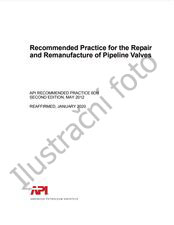Potřebujeme váš souhlas k využití jednotlivých dat, aby se vám mimo jiné mohly ukazovat informace týkající se vašich zájmů. Souhlas udělíte kliknutím na tlačítko „OK“.

API DR 148-ed.1997
HEALTH AND ENVIRONMENTAL SCIENCES DEPARTMENTAL REPORT - IDENTIFICATION OF ORGANIC TOXICANTS IN TREATED REFINERY EFFLUENTS
Přeložit název
NORMA vydána dne 1.12.1997
Informace o normě:
Označení normy: API DR 148-ed.1997
Datum vydání normy: 1.12.1997
Kód zboží: NS-1139447
Počet stran: 63
Přibližná hmotnost: 189 g (0.42 liber)
Země: Americká technická norma
Kategorie: Technické normy API
Anotace textu normy API DR 148-ed.1997 :
API DR 148, 1997 Edition, December 1997 - HEALTH AND ENVIRONMENTAL SCIENCES DEPARTMENTAL REPORT - IDENTIFICATION OF ORGANIC TOXICANTS IN TREATED REFINERY EFFLUENTS
OBJECTIVES AND SCOPE
Toxicity characterization procedures with either larval fathead minnow (Pimephales promelus) or (Mysidopsis bahia) were performed with effluents from five refineries to identify nonpolar organics responsible for chronic toxicity. Test species selected for this study are also commonly used for determining compliance with effluent discharge toxicity limits. Any toxicity caused by more easily recognized substances, such as ammonia, was not of concern.
Characteristics of selected refinery effluents were initially examined to determine suitable effluents for identification of nonpolar organic toxicants. Nonpolar organic toxicants were operationally defined as those adsorbed by C18 SPE columns. Desirable effluent characteristics were: 1) consistent presence of measurable chronic toxicity due to nonpolar organic compounds; and 2) a lack of toxicity from compounds other than nonpolar organics. Samples with these characteristics were preferred to minimize difficulties in tracking effluent toxicity through sample manipulations and to reduce the possibility of artifacts from the multiple treatments required to address toxicants belonging to more than one class of compounds.
Historically, several common difficulties have been encountered during identification of nonpolar organic toxicants in refinery effluents. Past problems included: 1) poor recovery of toxicity from C 18 solid phase extraction (SPE) columns, 2) poor resolution of toxicity during separative steps, 3) failure to recover toxicity following high performance liquid chromatography (HPLC) separation, and 4) inability to adequately simplify effluent fractions containing the nonpolar organic toxicants. Procedures were employed to: 1) simplify the toxic nonpolar organic effluent fraction, 2) achieve sufficient toxicant concentration to allow analytical measurement, and 3) remove water from the fraction to allow analysis by gas chromatography/mass spectroscopy (GUMS). GC analyses are often not definitive because of the hydrocarbon content of refinery effluents. To overcome these difficulties, modifications of the U.S. EPAs suggested guidance for Phase II Toxicity Identification Evaluation (TIE) procedures (U.S. EPA 1993) for nonpolar organic compounds were developed and tried.
Odebírejte informace o nově vydaných normách ZDARMA:
Chcete pravidelně odebírat informace o nově vycházejících normách z celého světa a to zcela zdarma?
Přihlašte se k odběru. Vše je velice jednoduché a absolutně ZDARMA.
Na výběr máte vydavatele z celého světa.



 Cookies
Cookies
